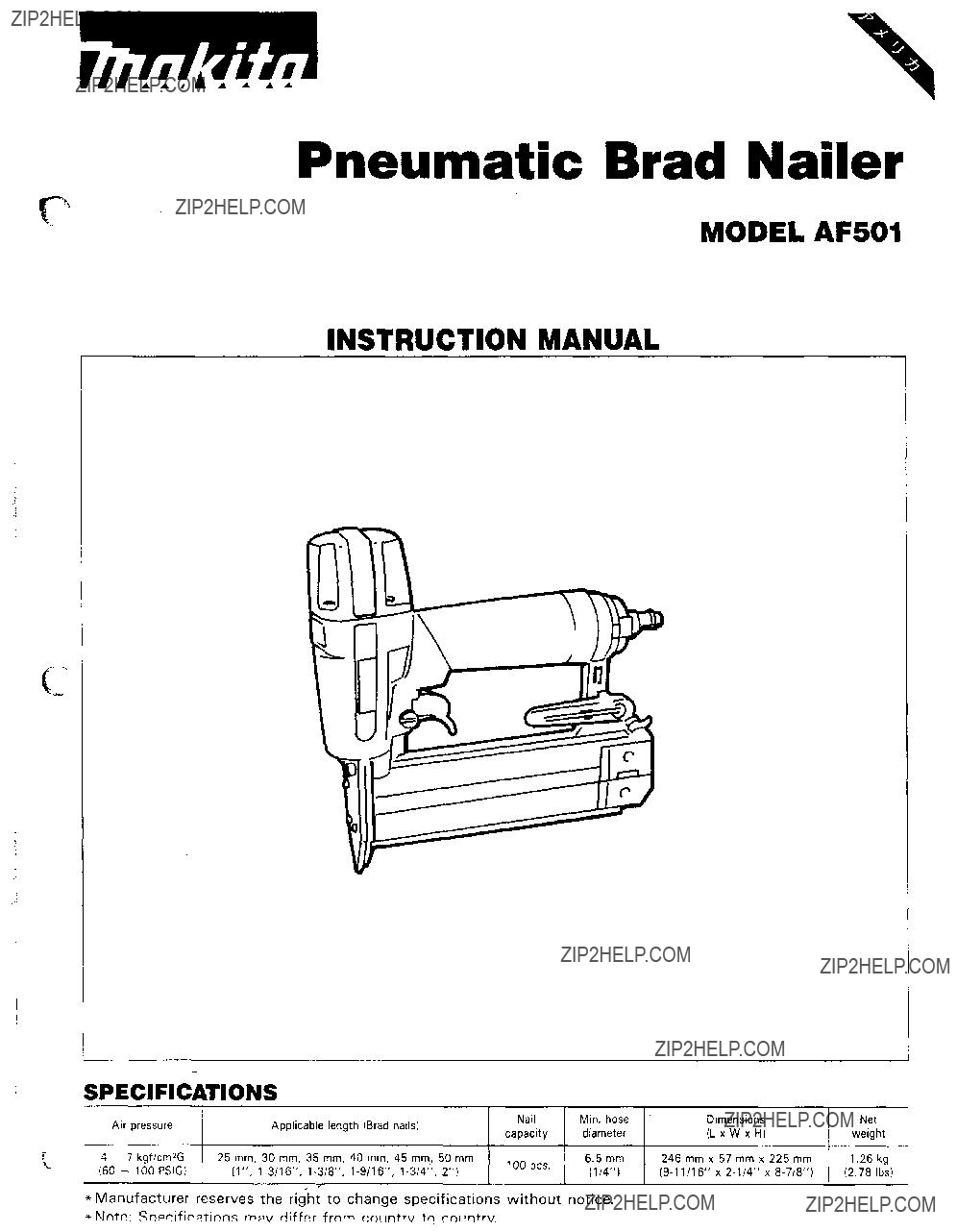
MODEL AF501
INSTRUCTION MANUAL

MODEL AF501
INSTRUCTION MANUAL
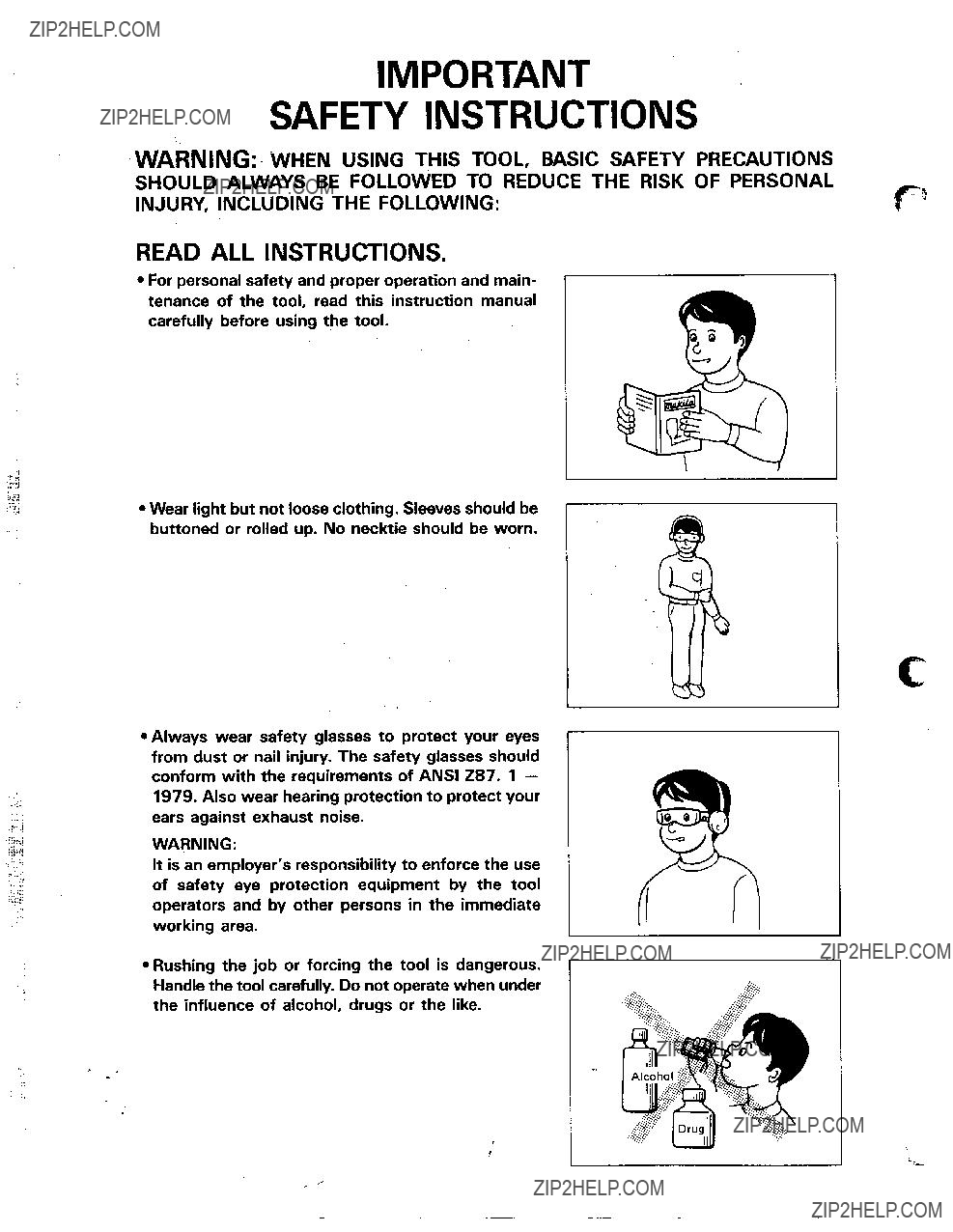
IMPORTANT
SAFETY INSTRUCTIONS
WARNING: WHEN USING THIS TOOL, BASIC SAFETY PRECAUTIONS
SHOULD ALWAYS BE FOLLOWED TO REDUCE THE RISK OF PERSONAL
INJURY, INCLUDING THE FOLLOWING:
READ ALL INSTRUCTIONS.
 For personal safety and proper operation and main-
For personal safety and proper operation and main-
tenance of the tool, read this instruction manual carefully before using the tool.
 Wear light but not loose clothing. Sleeves should be buttoned or rolled up. N o necktie should be worn.
Wear light but not loose clothing. Sleeves should be buttoned or rolled up. N o necktie should be worn.
.Rushing the job or forcing the tool is dangerous.
Handle the tool carefully. Do not operate when under the influence of alcohol, drugs or the like.
. .
. .
f?
e
,

 General Tool Handling Guidelines:
General Tool Handling Guidelines:
1 .Always assume that the tool contains fasteners.
2.Do not point the tool toward yourself or anyone whether it contains fasteners or not.
3.Never depress the operating control unless the nosepiece of the tool is directed toward the workpiece.
4.Respect the tool as a working implement. 5. No horseplay.
 Sparks sometimes fly when the tool is used. Do not use the tool near volatile, flammable materials such
Sparks sometimes fly when the tool is used. Do not use the tool near volatile, flammable materials such
as gasoline, thinner, paint, gas, adhesives, etc.; they will ignite and explode, causing serious injury.
 The area should be sufficiently illuminatedto assure safe operations.
The area should be sufficiently illuminatedto assure safe operations.
The area should be clear and litter- free. Be espe- cially careful to maintain good footing and balance.
:I
*Only those involved in the work should be in the vicinity. Children especially must be kept away at
all times.
I
I
3

 There may be local regulations concerning noise which must be complied with by keeping noise levels within prescribed limits. In certain cases, shutters should be used to contain noise.
There may be local regulations concerning noise which must be complied with by keeping noise levels within prescribed limits. In certain cases, shutters should be used to contain noise.
Shutter
 Do not tamper with the tool or attempt to use it for other than nailing.
Do not tamper with the tool or attempt to use it for other than nailing.
 Operate the tool within the specified air pressure of 4.0 - 7.0 kgf/cmZG(60 - 100 PSIG) for safety and longer tool life. Do not exceed the recommended max. operating pressure of 7 kgf/cm2G (100PSIG). The tool should not be connected to a source whose
Operate the tool within the specified air pressure of 4.0 - 7.0 kgf/cmZG(60 - 100 PSIG) for safety and longer tool life. Do not exceed the recommended max. operating pressure of 7 kgf/cm2G (100PSIG). The tool should not be connected to a source whose
pressure potentially exceeds 14.0 kgf/cmzG (200 PSIG).
...
..>
1 ..
*
.I.
. .
 Never use the tool with other than compressed air. If
Never use the tool with other than compressed air. If
gen, hydrogen, propane, acetylene, etc.) is used as a power source for this tool, the tool will explode
and cause serious injury.
4

 Always check the tool for its overall condition and loose screws before operation. Tighten as required.
Always check the tool for its overall condition and loose screws before operation. Tighten as required.
 Make sure the safety mechanism is in working order
Make sure the safety mechanism is in working order
before operation. First, disconnect the hose from the tool and open the magazine. Turn the lock knob (lock pin) to make sure the trigger is locked and released alternately with every quarter turn of the lock knob (lock pin).
 Check walls, ceilings, floors, roofing and the like carefully to avoid possible electrical shock, gas leakage, explosions, etc. caused by striking lives wires, conduits or gas pipes.
Check walls, ceilings, floors, roofing and the like carefully to avoid possible electrical shock, gas leakage, explosions, etc. caused by striking lives wires, conduits or gas pipes.
ELock kno b (Lock pin)
Live wire 2
5

 Us e only nails specified in this manual. The use of any other nails may cause malfunction of the tool.
Us e only nails specified in this manual. The use of any other nails may cause malfunction of the tool.
 Do not permit those uninstructed to. use the tool.
Do not permit those uninstructed to. use the tool.
 Make sure no one is nearby before nailing. Never attempt to nail from both the inside and outside at the same time. Nails may rip through and/or fly off,
Make sure no one is nearby before nailing. Never attempt to nail from both the inside and outside at the same time. Nails may rip through and/or fly off,
presenting a grave danger.
 Watch your footing and maintain your balance with the tool. Make sure there is no one below when working in high locations, and secure the air hose to prevent danger if there is sudden jerking or catching.
Watch your footing and maintain your balance with the tool. Make sure there is no one below when working in high locations, and secure the air hose to prevent danger if there is sudden jerking or catching.

 On rooftops and other high locations, nail as you move forward. It is easy to lose your footing if you
On rooftops and other high locations, nail as you move forward. It is easy to lose your footing if you
nail while inching backward. When nailing against perpendicular surface, nail from the top to the
bottom. You can perform nailing operations with less fatigue by doing so.
 A nail will be bent or the tool can become jammed if you mistakenly nail on top of another nail or strike
A nail will be bent or the tool can become jammed if you mistakenly nail on top of another nail or strike
a knot in the wood. The nail may be thrown and hit someone, or the tool itself can react dangerously. Place the nails with care.
I
c  Do not leave the loaded tool or the air compressor under pressure for a long time out in the sun. Be sure
Do not leave the loaded tool or the air compressor under pressure for a long time out in the sun. Be sure
that dust, sand, chips and foreign matter will not enter the tool in the place where you leave it setting.
*D o not point the ejection port at anyone in the
vicinity. Keep hands and feet away from the ejection port area.
7

*When the air hose is connected, do not carry the tool with your finger on the trigger or hand it to someone in this condition. Accidental firing can be extremely dangerous.
 Handle the tool carefully as there is high pressure inside the tool that can be dangerous if a crack is
Handle the tool carefully as there is high pressure inside the tool that can be dangerous if a crack is
caused by rough handling (dropping or striking). Do not attempt to carve or engrave on the tool.
 Stop nailing operations immediately if you notice something wrong or out of the ordinary with the
Stop nailing operations immediately if you notice something wrong or out of the ordinary with the
tool.
 Always lock the trigger, disconnect the air hose and remove all of the nails before inspection, main- tenance, relocating, or after operation is over.
Always lock the trigger, disconnect the air hose and remove all of the nails before inspection, main- tenance, relocating, or after operation is over.
8
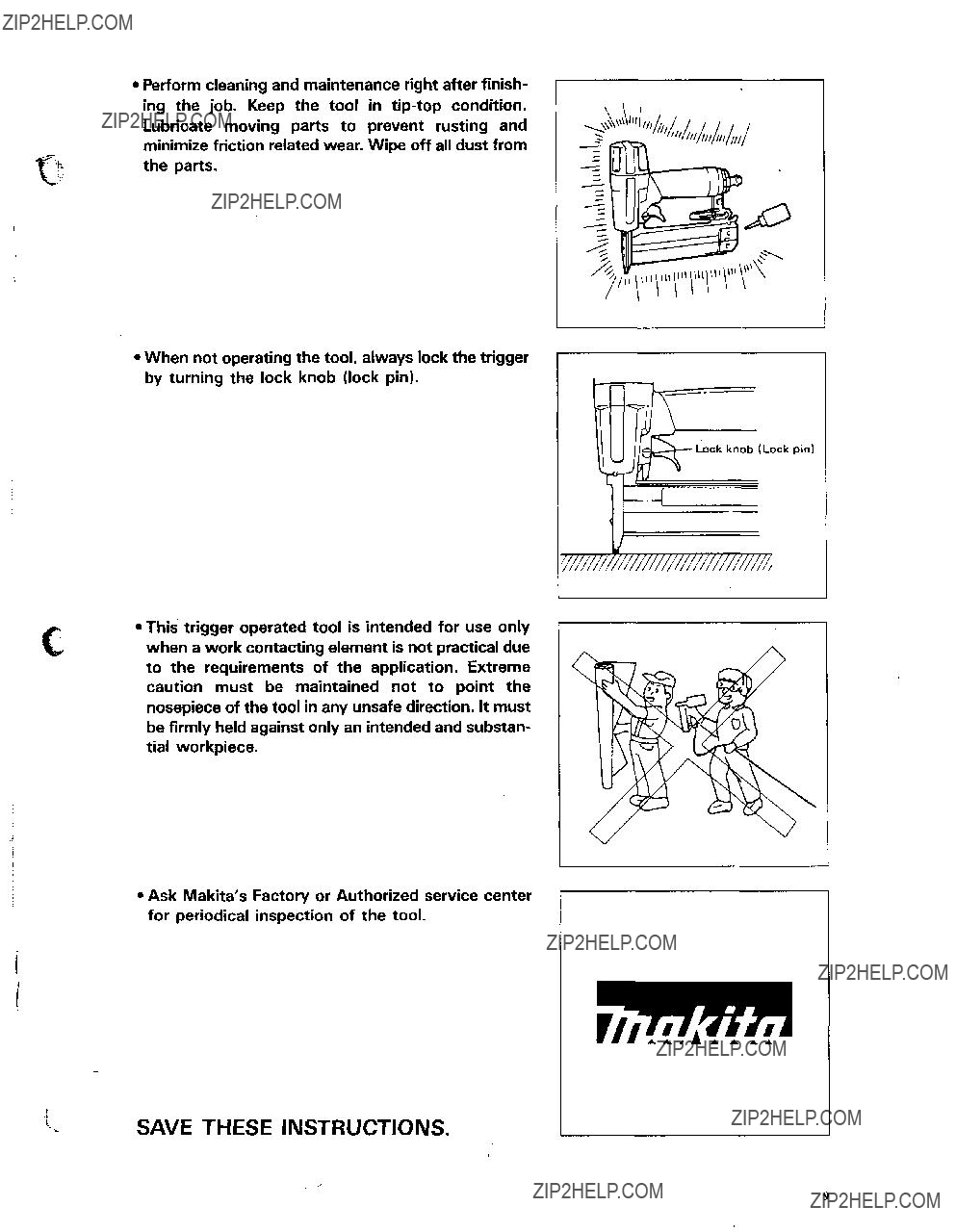
 When not operating the tool, always lock the trigger by turning the lock knob (lock pin).
When not operating the tool, always lock the trigger by turning the lock knob (lock pin).
 Ask Makita's Factory or Authorized service center for periodical inspection of the tool.
Ask Makita's Factory or Authorized service center for periodical inspection of the tool.
i
Lock knob (
9
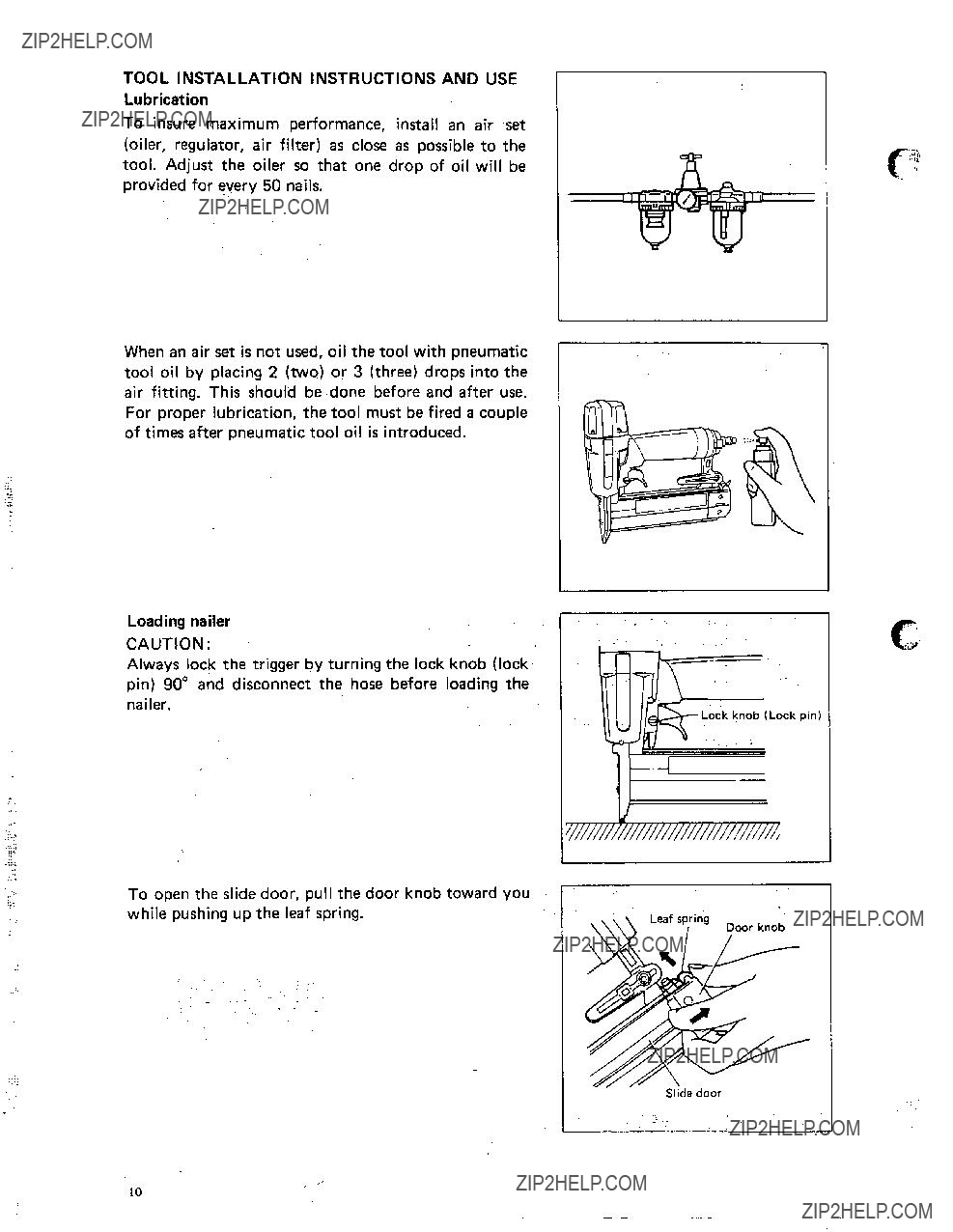
TOOL INSTALLATION INSTRUCTIONS AND USE Lubrication
To insure maximum performance, install an air set (oiler, regulator, air filter) as close as possible to the tool. Adjust the oiler so that one drop of oil will be provided for every 50 nails.
When an air set is not used, oil the tool with pneumatic tool oil by placing 2 (two) or 3 (three) drops into the air fitting. This should be done before and after use. For proper lubrication, the tool must be fired a couple of times after pneumatic tool oil is introduced.
To open the slide door, pull the door knob toward you while pushing up the leaf spring.
Slide door
10

Load nails into the magazine so that the nail points
will be set into the groove at the bottom of the maga- zine. Move the nails into the ejection slot as far as they will go.
To close the slide door, slide it toward the driver guide until the slide door is locked by the leaf spring.
Adjusting depth of nailing
CAUTION :
Always lock the trigger and disconnect the hose before adjusting the depth of nailing.
The depth of nailing can be adjusted by moving the driver guide up or down. When moving the driver guide to the higher position, you can obtain a deeper depth of nailing; when moving it to a lower position, you can obtain the shallower depth of nailing. To adjust the depth of nailing, proceed as follows:
1 . Remove hex wrench 3 from the hook.
.
I
1 1
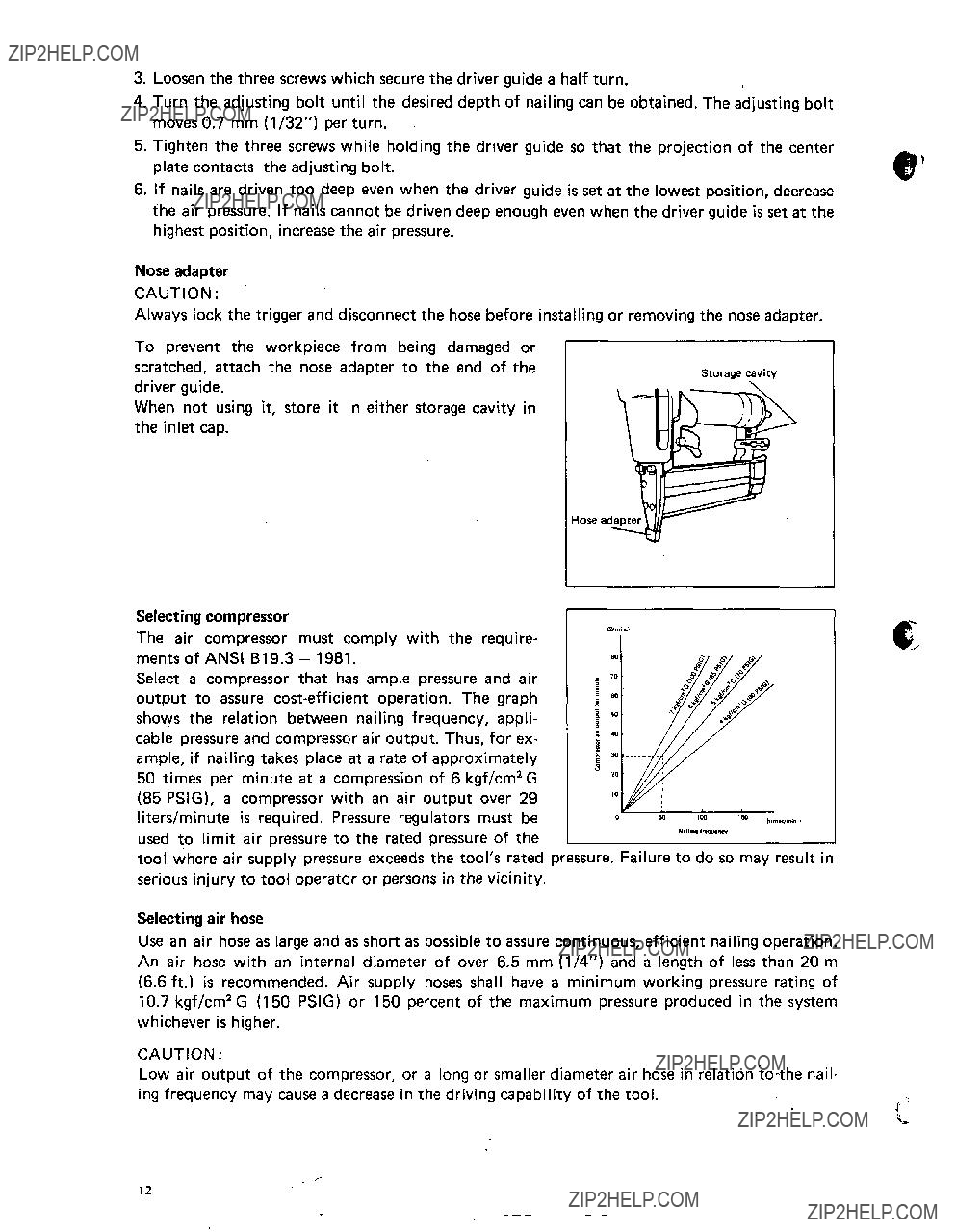
the air pressure. If nails cannot be driven deep enough even when the driver guide is set at the highest position, increase the air pressure.
Nose adapter
CAUTION :
Always lock the trigger and disconnect the hose before installing or removing the nose adapter.
To prevent the workpiece from being damaged or I scratched, attach the nose adapter to the end of the driver guide.
When not using it, store it in either storage cavity in the inlet cap.
Storage cavity
Hose
Selecting compressor
The air compressor must comply with the require- ments of ANSI B19.3 - 1981.
Select a compressor that has ample pressure and air output to assure
used to limit air pressure to the rated pressure of the
tool where air supply pressure exceeds the tool's rated pressure. Failure to do so may result in serious injury to tool operator or persons in the vicinity.
Selecting air hose
Use an air hose as large and as short as possible to assure continuous, efficient nailing operation. An air hose with an internal diameter of over 6.5 m m (1/4") and a length of less than 20 m (6.6ft.) is recommended. Air supply hoses shall have a minimum working pressure rating of 10.7 kgf/cm2G (150 PSIG) or 150 percent of the maximum pressure produced in the system whichever is higher.
CAUTION :
Low air output of the compressor, or a long or smaller diameter air hose in relation
,
12
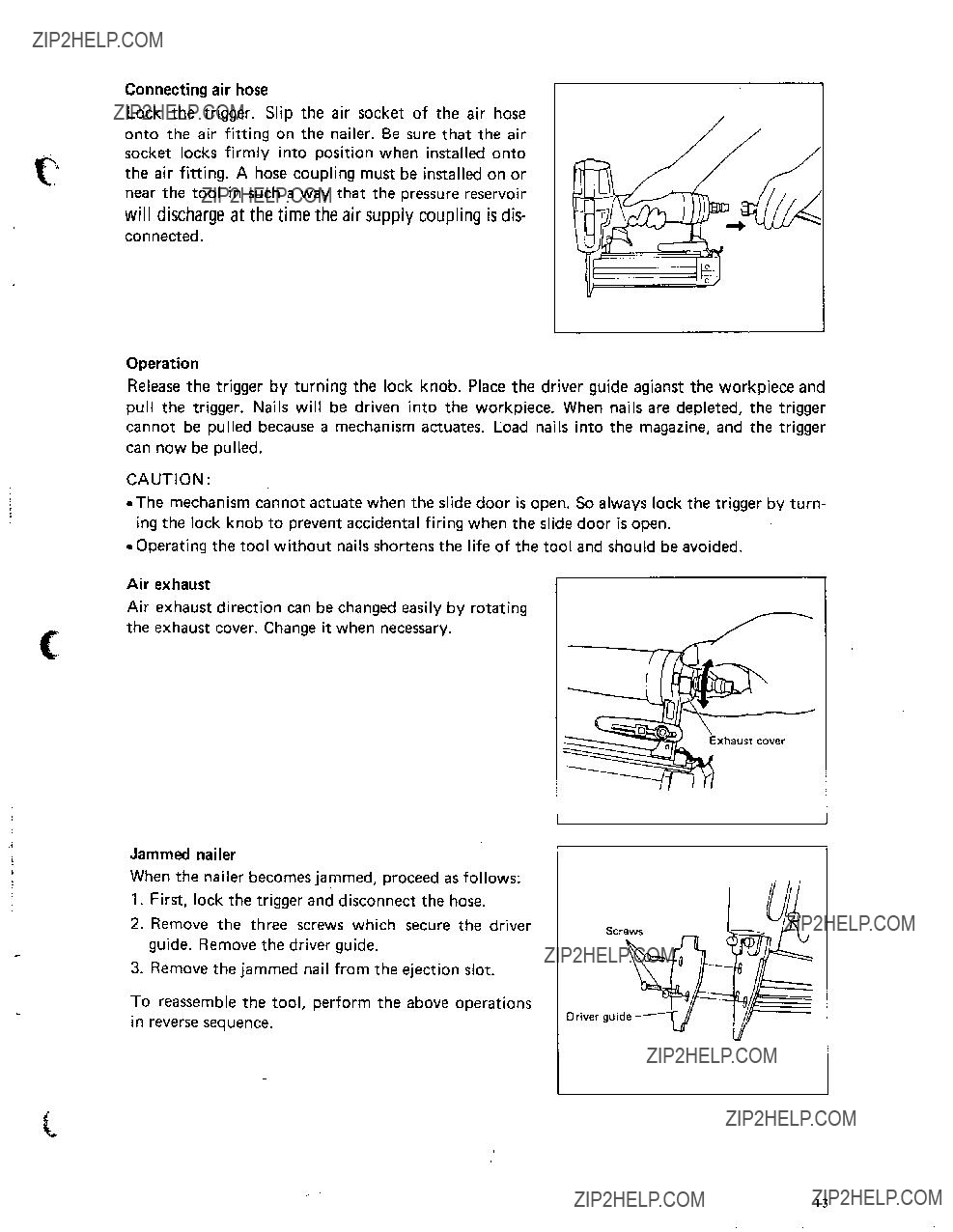
I
I
.i
II
Operation
Release the trigger by turning the lock knob. Place the driver guide agianst the workpiece and
pull the trigger. Nails will be driven into the workpiece. When nails are depleted, the trigger cannot be pulled because a mechanism actuates. Load nails into the magazine, and the trigger
can now be pulled.
CAUTION :
.The mechanism cannot actuate when the slide door is open. So always lock the trigger by turn- ing the lock knob to prevent accidental firing when the slide door is open.
 Operating the tool without nails shortens the life of the tool and should be avoided.
Operating the tool without nails shortens the life of the tool and should be avoided.
Air exhaust
Air exhaust direction can be changed easily by rotating the exhaust cover. Change it when necessary.
xhaust cover
Jammed nailer
When the nailer becomes jammed, proceed as follows: 1 . First, lock the trigger and disconnect the hose.
2.Remove the three screws which secure the driver guide. Remove the driver guide.
3.Remove the jammed nail from the ejection slot.
To reassemble the tool, perform the above operations in reverse sequence.
13

Hook
The hook is convenient for hanging the tool tempo- rarily. This hook can be installed on either side of the tool.
CAUTION :
.Always lock the trigger and disconnect the hose when hanging the tool using the hook.  Never hang the tool on a waist belt or the like. Dangerous accidental firing may result.
Never hang the tool on a waist belt or the like. Dangerous accidental firing may result.
strips have been handled roughly, they may be out of shape or their connector breaks, causing poor nail feed.
Avoid storing nails in a very humid or hot place or place exposed to direct sunlight.
14
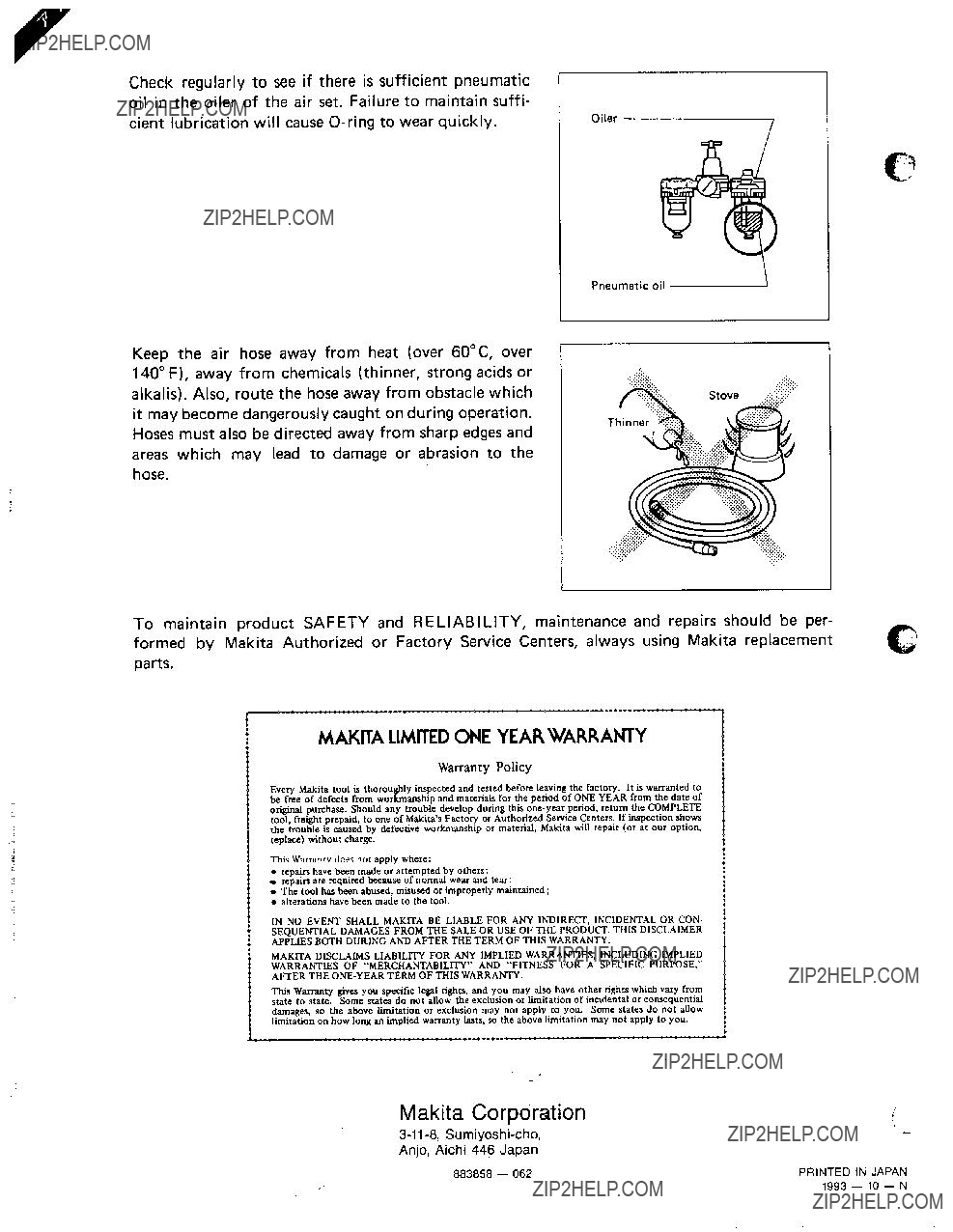
Check regularly to see if there is sufficient pneumatic oil in the oiler of the air set. Failure to maintain suffi-
cient lubrication will cause
Keep the air hose away from heat (over 60??C, over 140???F), away from chemicals (thinner, strong acids or alkalis). Also, route the hose away from obstacle which it may become dangerously caught on during operation. Hoses must also be directed away from sharp edges and areas which may lead to damage or abrasion to the hose.
Oiler 7
Pneumatic oil 2
To maintain product SAFETY and RELIABILITY, maintenance and repairs should be per- formed by Makita Authorized or Factory Service Centers, always using Makita replacement
parts.
f
MAKrfA LIMITED ONE YEARWARRANTY
1
Makita Corporation
Anjo, Aichi 446 Japan